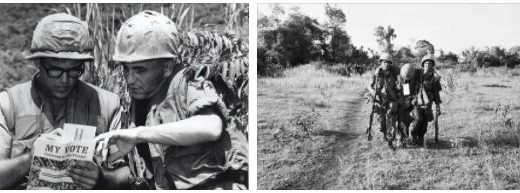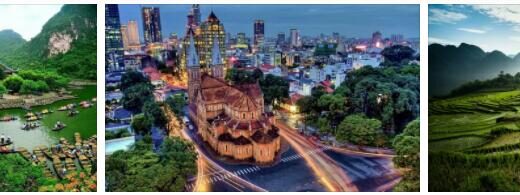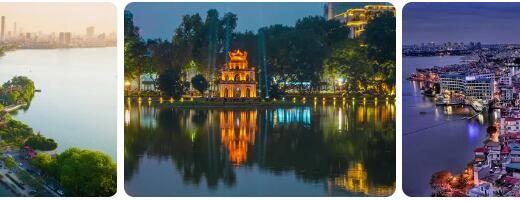Sights of Hue, Vietnam
The centrally located city of Hue is a popular destination among travelers who love culture and nature. The Vietnamese city of Hue was once the country’s imperial capital. Since Unesco has underlined the former Imperial City as a World Heritage Site, it is impossible to imagine Vietnam’s top sights without it. The city of Hue has endured quite a bit of misery in the past. During the Vietnam War, this part of Vietnam was heavily bombed and much of the city was badly damaged. Executions and heavy fighting decimated the population enormously at the time. The country and the city of Hué are now scribbling up nicely. Beautiful new buildings are being erected in various places and modernization is increasing rapidly. Several modern museums, the Cho Dong Ba Market, Hue University, the Truong Tien Bridge and the much loved Hue Festival are good examples of this. In addition, the many monumental sights, including the imperial tombs, temples and the beautiful nature in and around the nearby Bach Ma National Park and the Perfume River, provide the city with a lot of tourism. Partly because of this, sufficient money is generated to restore lost beauties from the past. temples as well as the beautiful nature in and around the nearby Bach Ma National Park and the Perfume River, the city attracts a lot of tourism. Partly because of this, sufficient money is generated to restore lost beauties from the past. temples as well as the beautiful nature in and around the nearby Bach Ma National Park and the Perfume River, the city attracts a lot of tourism. Partly because of this, sufficient money is generated to restore lost beauties from the past.
Top 10 things to do in Hue
#1. Imperial City
On the west bank of the Perfume River ‘Song Huong’ lies the ancient Imperial City of Hue. This walled part of history has been registered with Unesco since 1993 on the list of world heritage sites. The former Imperial City of Hue was for a long time the center of the Nguyen dynasty, the last royal family of Vietnam. It was founded at the beginning of the nineteenth century by Emperor Gia Long. The ruins of the ‘Forbidden Purple City’ and the imperial palaces, pagodas, bastions, covered walkways, canals and theater are top sights of Vietnam. Some parts of the Imperial City have been restored in the past. Because bombs were also thrown here during the Indochina Wars. The first building you enter behind the entrance gate is the main palace ‘Thai Hoa’. Here you will find a model of the Imperial City and, among other things, a film about its history. During the Nguyen dynasty, coronations and other important ceremonial celebrations took place here. Behind this is the ‘Pavilions of the Mandarins’. During your visit, you should definitely visit the Imperial Theater, the Imperial Library and the Dien Tho Palace.
#2. Tomb of Tu Duc
According to Homosociety.com, the imperial tombs from the Nguyen dynasty are located south of Hue near the village of Thuong Hai. The fourth and longest-reigning emperor, Tu Duc, himself ordered the construction of his tombs here. Its construction took about three years. Eventually, the estate also became a residence where the emperor and his many wives regularly stayed. On the estate you will also find the Xung Khiem pavilion, the Hoa Khiem temple and the Minh Khiem Duong complex with the royal theater. Yet there is speculation about the real burial place of Emperor Tu Duc. This would be buried in the greatest secrecy in a secret place in Vietnam. Everyone who participated in this and was aware of it was then executed. Other imperial tombs in the area include those of Minh Mang, Dong Khanh, Thieu Tri, Khai Dinh and Gia Long. However, the tomb of Tu Duc is the most beautiful.
#3. Thien Mu Pagoda
On the other side of the Perfume River, the figure of the Thien Mu Pagoda rises. This pagoda means freely translated, the Pagoda of the Celestial White Lady. This walled complex includes a seven-storey stupa ‘Thap Phuoc Duyen’ which can be clearly seen from the waterfront. An image of Buddha can be seen on every floor. Around this are four small square buildings, including a bronze clock from 1707 and in another building a marble turtle that carries a tablet with text from Buddhism. Further on is Thien Mu Pagoda, a monastic residence where monks still reside, and a blue Austin that once belonged to Thich Quang Duc. Thich Quang Duc was transported to Saigon in 1963 with this car. Once he arrived, he set himself on fire in protest against Diem’s regime. With this he fought against the discrimination that many Buddhist monks had to deal with at the time. Many followed his example. At the very back of the garden you will find a small tower which indicates the grave of the Buddhist leader Thich Don Hau.
#4. Tomb of Dong Khanh
The tomb of Emperor Dong Khanh can be found within the Tu Doc Tomb complex. This emperor died at the age of twenty-five and reigned only three years. This death was completely unexpected. At that time he was busy building Ngung Hy temple next to his father’s tomb. His own tomb was only built in 1916, commissioned by his son Khai Dinh. To reach Dong Khanh’s tomb, you have to climb a number of steps. The square in front of the complex is dominated by beautiful statues of soldiers, an elephant, a horse and other Asian figures.
#5. Tomb of Khai Dinh
In the year 1916, Khai Dinh, a descendant of Dong Khanh, was crowned as emperor. He succeeded Duy Tan as the twelfth emperor. Khai Dinh was a much-discussed emperor of Vietnam who died at the age of forty-one. His reign ended on November 6, 1925. He was known as a flamboyant person who liked to gamble and had a penchant for make-up. His grave is also different from the other tombs in the area. For example, the tomb of Khai Dinh shows clear European influences. The tomb of Khai Dinh is located within the imperial walls of the estate that also houses the tomb of Emperor Tu Duc.
#6. Notre Dame Cathedral
On the Nguyen Hue, is the city’s Notre Dame. Where you expect a huge imposing church, you will be disappointed here in Hué. The city’s Notre Dame is little more than a modest and modest blue and white painted cathedral. The design is perhaps the most special thing about this building. The cathedral, built in Franco-Asian style, was built around 1937.
#7. Museum of Imperial Antiquities
Just outside the city walls of the former Imperial City of Hue, you have the opportunity to visit the Museum of Imperial Antiquities. This museum on Le Truc street is an excellent addition to your visit to the Imperial Forbidden City. It was founded in 1923 in the former Long An palace. You will find traditional royal clothing, silver objects, antique statues from the Cham era, authentic furniture including royal beds, bronze vases and bells, paintings and beautiful porcelain. The museum is closed on Mondays.
#8. Perfume River
The Song Huong River is now better known as the Perfume River. The river flows through the Vietnamese province of Thua Thien-Hue and the city of Hue itself. The name is derived from the fact that flowers fall into the water at the end of summer and in autumn and are carried away by the current. The Perfume River is very popular with tourists. The river is often a chosen route to transport you by dragon boat to the Thien Mu Pagoda and the nearby village of Thuong Hai. At this village you come ashore at a piece of jungle where many families are engaged in making and selling incense. Along the side of the road are several stalls where you can make your own incense sticks, paintings or other handmade items. However, most people visit the village of Thuong Hai to visit the Imperial Tombs from the Nguyen dynasty.
#9. Thanh Toan bridge
Just outside the center of the city of Hue, you can visit the beautiful old wooden Thanh Toan bridge. The first Thanh Toan bridge was built here in the village of Thanh Thuy Chanh around the eighteenth century. Several renovations have already taken place. On the bridge, the woman Tran Thi Dao is worshiped. As a descendant of the influential Tran family, she donated personal capital to provide the village with this bridge, so that the canal could be easily crossed. The bridge is seventeen meters long and four meters wide. The love for this bridge has made the inhabitants of the village decide several times to rebuild and restore it when it has been hit again and again by storms and wars. It is a particularly nice part to cycle from Hue. The tranquility and the views make the trip more than pleasant.
#10. Ho Chi Minh Museum
The museum ‘Bao Tang Ho Chi Minh’ is located on the Le Loi in the city of Hue. The entire museum was created to honor the revolutionary leader Ho Chi Minh. On the ground floor you will find regularly changing exhibitions. The permanent collection of the museum mainly shows rooms and objects that Ho Chi Minh used during his life. You can admire his bedroom, meeting rooms and also a bunker. There are also photos and documents available that tell a little more about him as a person.



